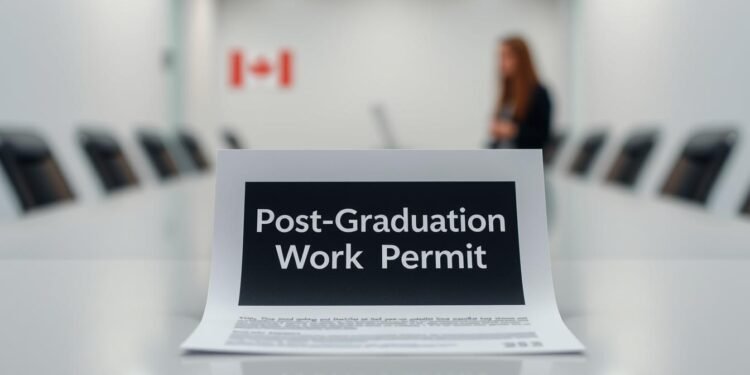Are you ready to turn your international education into a career opportunity? Starting November 2024, significant changes to the post-graduation work permit program will reshape how graduates plan their futures. These updates could be the key to unlocking your professional dreams.
New field of study requirements will impact diploma and certificate holders, while master’s graduates will enjoy a special exception—a 3-year work permit regardless of program length. Understanding these changes is crucial for anyone navigating the Canadian immigration process.
This guide will walk you through the latest updates, eligibility criteria, and application steps. Whether you’re preparing for your study program or already planning your next move, staying informed is your first step toward success.
Key Takeaways
- New field of study rules take effect November 1, 2024.
- Master’s graduates qualify for a 3-year work permit, regardless of program length.
- Understanding CIP codes is essential for aligning with labor market needs.
- Incomplete applications or misrepresentation can lead to serious consequences.
- Language proficiency requirements vary by academic level.
- Maintaining legal status during processing is critical.
What is the Canada Post-Graduation Work Permit (PGWP)?
The Post-Graduation Work Permit is a gateway to professional growth for international graduates. It’s an open work permit that allows recent graduates from designated learning institutions (DLIs) to gain valuable work experience in Canada. This program is not automatic—applicants must meet specific criteria to qualify.
Overview of the PGWP Program
The primary purpose of this work permit is to help graduates transition from their study program to the workforce. It’s a critical step for those aiming to build a career in Canada and explore pathways to permanent residency. Graduates can work in any industry, anywhere in the country, without needing a job offer beforehand.
However, this opportunity is available only once per lifetime. It’s not accessible to exchange students, visiting students, or those enrolled in English language programs. To qualify, you must have completed a program at an eligible DLI.
Benefits of Obtaining a PGWP
One of the key advantages of this work permit is the ability to gain Canadian work experience, which is essential for many permanent residency programs. Graduates can work full-time, part-time, or even be self-employed, providing flexibility to explore diverse career paths.
Additionally, the permit serves as a bridge between education and eligibility for programs like Express Entry. It’s a unique opportunity to enhance your skills, build professional networks, and contribute to the Canadian economy.
Who is Eligible for the Canada PGWP?
Understanding eligibility for the work permit program is the first step toward your career goals. To qualify, you must meet specific criteria based on your study program and other requirements. These rules ensure that only eligible graduates can access this opportunity.
General Eligibility Criteria
To be eligible, you must have completed a program at a designated learning institution (DLI). The program must be at least 8 months long. You also need to maintain full-time student status during your study, with exceptions for approved breaks.
Additionally, at least 50% of your study must be completed in person. Online or distance learning programs do not qualify unless they meet specific exceptions. These rules ensure that graduates have hands-on experience in their field.
Program-Specific Requirements
The length of your program determines the duration of your work permit. Programs lasting 8 months to 2 years grant a permit equal to the program length. For programs over 2 years, you may qualify for a 3-year permit.
Master’s degree holders receive a special exception. Regardless of program length, they are eligible for a 3-year work permit. This provides flexibility for advanced degree holders to explore career opportunities.
Exceptions and Special Cases
Accelerated programs may still qualify if they meet the minimum duration requirement. However, study breaks or incomplete programs can affect eligibility. Graduates with scholarships from certain organizations may face restrictions.
Starting November 2024, new field of study rules will apply. Ensure your program aligns with labor market needs to remain eligible. Staying informed about these changes is crucial for a successful application.
Key Changes to PGWP Eligibility Starting November 1, 2024
Starting November 2024, significant updates will reshape eligibility for the work permit program. These changes aim to align educational programs with labor market needs and ensure graduates meet specific requirements. Understanding these updates is essential for a successful application.
New Field of Study Requirements
One of the most notable changes is the introduction of new field of study requirements. College and non-degree students must now enroll in programs that align with in-demand sectors. These include healthcare, STEM, trades, and other targeted fields.
The IRCC will use the Classification of Instructional Programs (CIP) codes to identify eligible programs. These codes will align with the National Occupation Classification (NOC) system, ensuring graduates meet labor market needs. This dynamic list will be updated regularly to reflect changing demands.
Diploma and certificate programs will be particularly affected. Applicants must ensure their training aligns with the updated requirements to remain eligible. Transition rules will apply for those who started their studies before November 2024.
Language Proficiency Standards
Language requirements will also see updates. University students must demonstrate a language proficiency level of CLB 7 or NCLC 7. For college students, the minimum level is CLB 5.
Approved tests include IELTS, CELPIP, and TEF. These tests ensure applicants meet the necessary language skills for success in the workforce. Non-compliance with these standards can lead to application delays or rejections.
These changes aim to ensure graduates are well-prepared for the Canadian job market. Staying informed and meeting the new requirements is crucial for a smooth application process.
How to Determine Your PGWP Eligibility
Navigating the eligibility criteria for work permits starts with understanding the Classification of Instructional Programs (CIP). This system categorizes educational programs based on their field of study and aligns them with labor market needs. By verifying your program’s CIP code, you can ensure it meets the updated requirements.
Using the Classification of Instructional Programs (CIP)
The CIP code system is a standardized way to classify educational programs. To verify your program’s code, use the official search tool provided by Statistics Canada. This step-by-step process ensures your training aligns with the latest eligibility criteria.
Program titles may differ from official CIP listings, so cross-referencing is essential. Misinterpreting the taxonomy structure can lead to errors, so take time to understand the hierarchy. Accurate code selection is critical for a successful application.
Aligning CIP Codes with National Occupation Classification (NOC)
Once you’ve identified your CIP code, cross-reference it with the NOC demand lists. These lists highlight occupations in high demand, ensuring your field of study aligns with labor market needs. The IRCC regularly updates these lists to reflect changing economic priorities.
Using resources like the IRCC’s occupation shortage lists can further guide your verification process. International student advisors can also provide valuable insights into common CIP lookup mistakes to avoid.
By ensuring your program’s CIP code matches the NOC system, you increase your chances of meeting eligibility requirements. This alignment is a crucial step in securing your work permit and advancing your career.
Documents Required for the PGWP Application
Gathering the right documentation is a critical step in your application process. Providing accurate and complete paperwork ensures your submission meets all requirements. Missing or incorrect documents can lead to delays or rejections, so it’s essential to double-check everything.

Essential Documents for All Applicants
Every applicant must submit proof of program completion. This includes an official transcript and a letter from your institution confirming your graduation. Your passport must also be valid for the duration of your intended stay.
Language test results are required to demonstrate proficiency. Approved tests include IELTS, CELPIP, and TEF. Ensure your scores meet the minimum standards for your academic level.
Additional Documents for Specific Cases
Certain situations may require extra paperwork. For example, applicants with a history of extended leaves or program transfers must provide detailed explanations. Accelerated program graduates should include proof of program duration.
If your occupation requires it, a medical exam or police clearance certificate may be necessary. Proof of funds is also required to show you can support yourself during your stay. Special cases, such as scholarships or study permits, may have additional requirements.
By preparing these documents in advance, you can streamline your application process and avoid unnecessary delays. Double-check all requirements to ensure a smooth submission.
Step-by-Step Guide to Applying for the Canada PGWP
Applying for a work permit after your studies is a straightforward process if you follow the right steps. This guide will walk you through each stage, from confirming eligibility to submitting your application. Staying organized and meeting deadlines is key to a smooth process.
Step 1: Confirm Your Eligibility
Before starting your application, ensure you meet all eligibility criteria. Verify that your program qualifies and that you’ve completed it within the required timeframe. Remember, you must apply within 180 days of your completion date.
Step 2: Gather Required Documents
Prepare all necessary paperwork, including your official transcript, graduation letter, and language test results. Use the IRCC’s document checklist (IMM 5583) to ensure nothing is missing. Certified translations may be required for non-English documents.
Step 3: Complete the Application Form
Fill out the application form accurately. Double-check all details to avoid errors. Whether you choose an online or paper application, ensure all sections are complete. Incomplete forms can delay processing.
Step 4: Pay the Application Fee
The work permit fee is $255 CAD. Payment can be made online or through other approved methods. Keep a receipt for your records. Fees are non-refundable, so ensure your application is correct before submitting.
Step 5: Submit Your Application
Once everything is ready, submit your application through the IRCC portal or by mail. After submission, you may need to provide biometrics. Track your application status online to stay updated on its progress.
By following these steps, you can navigate the process with confidence. Stay organized, meet deadlines, and double-check all details to ensure a successful application.
How Long Does the PGWP Application Process Take?
Understanding the timeline for your work permit application is crucial for planning your next steps. The process can take anywhere from 80 to 180 days, depending on various factors. Staying informed about these timelines helps you manage expectations and prepare accordingly.
Average Processing Times
Currently, the average processing time ranges between 80 and 180 days. However, these timelines can vary based on the volume of applications received by the immigration office. During peak seasons, such as summer graduations, processing may take longer due to increased demand.
Factors That Can Affect Processing Time
Several elements can influence how long it takes to receive a decision. Incomplete documentation is a common cause of delays. Ensure all required paperwork is accurate and submitted on time to avoid setbacks.
The complexity of your application also plays a role. Cases requiring additional security or background checks may take longer. Additionally, the COVID-19 backlog continues to impact processing times in some instances.
If you need urgent processing, you can request expedited review, but approval is not guaranteed. Responding promptly to any queries from the immigration office can also help speed up the process.
What to Do While Waiting for Your PGWP Decision
Waiting for your work permit decision can be a critical period, but knowing your options ensures a smooth transition. During this time, it’s essential to maintain your legal status and understand the rules surrounding work and travel. Staying informed helps you avoid unnecessary complications.
Maintaining Legal Status in Canada
While your application is being processed, you may be on implied status. This means you can stay in the country legally as long as you applied before your previous permit expired. However, certain conditions apply, so it’s crucial to verify your eligibility.
If your permit expires during the application process, you must stop working unless you qualify for interim work authorization. Renewing your temporary resident visa or extending your stay may also be necessary to remain compliant.
Working While Your Application is Processed
If you meet IRCC’s 186(a) criteria, you can continue working full-time while waiting for a decision. This includes having a valid study permit and meeting specific rules. However, if your application is refused, you must stop working immediately.
Changing employers during this period is allowed, but you must ensure your new job complies with the conditions of your permit. Employers are also required to verify your eligibility to work under interim authorization.
Travel restrictions may apply while on implied status. Leaving the country could result in losing your authorization to return. Additionally, maintaining health insurance coverage is vital to protect yourself during this transitional phase.
Preparing for potential refusal scenarios is also wise. Understanding your options and seeking professional advice can help you navigate any challenges that arise.
How Long is the Canada PGWP Valid?
Determining the validity of your work permit is essential for planning your career path. The duration of your permit depends on the length of your study program and specific exceptions. Understanding these factors ensures you make the most of this opportunity.
Duration Based on Program Length
The length of your work permit is calculated based on the duration of your study program. For every month of study, you receive one month of permit validity, up to a maximum of three years. For example, an 8-month program grants an 8-month permit, while a 2-year program qualifies you for a 3-year permit.
Accelerated programs are assessed based on their actual duration, not the shortened completion time. Part-time study may reduce your eligibility, while co-op programs include work terms in the calculation. Lost time due to strikes or leaves of absence may also impact your permit’s validity.
Exceptions for Master’s Degree Holders
Master’s degree graduates receive a special exception. Regardless of the program length, they are eligible for a 3-year work permit. This provides flexibility for advanced degree holders to explore career opportunities and gain valuable work experience.
If your passport expires before the permit’s validity period, you can apply for an extension. Ensure your passport is valid for the entire duration to avoid complications. Dual degree programs and provincial vs. federal differences may also affect your eligibility.
By understanding these rules, you can plan your career path effectively and maximize the benefits of your work permit.
Extending Your PGWP: What You Need to Know
Extending your work permit requires careful planning and attention to detail. Whether your current permit is nearing expiration or you need more time to achieve your career goals, understanding the extension process is crucial. This section covers everything from eligibility to documentation requirements.

When and How to Apply for an Extension
To extend your work permit, you must submit a paper application with your new passport. The extension period will match your original eligibility based on your study program. Ensure your application is complete to avoid delays.
Key steps include gathering all required documentation, such as proof of program completion and a valid passport. You’ll also need to pay the application fee, which is non-refundable. Processing times vary, so apply well before your current permit expires.
Passport Validity Considerations
Your passport must be valid for the entire duration of your extended permit. If your passport expires sooner, you’ll need to renew it before applying. A mismatch between your passport and permit validity can lead to complications.
Plan ahead to ensure your passport renewal aligns with your extension timeline. This step is critical for a smooth application process and uninterrupted work authorization.
- Eligibility criteria for extensions
- Required supporting documents
- Fee structure for extension applications
- Maintaining status during extension processing
- Multiple extension limitations
- Passport renewal timeline strategies
- Border vs inland application options
- Transitioning to other permit types
Common Mistakes to Avoid in Your PGWP Application
Avoiding common errors can make or break your work permit application. Small oversights, like incorrect program classification or missing paperwork, can lead to delays or even rejections. Understanding these pitfalls ensures a smoother process and increases your chances of success.
Incorrect CIP Code Selection
Choosing the wrong Classification of Instructional Programs (CIP) code is a frequent mistake. This error can lead to misrepresentation, which carries serious consequences. To avoid this, verify your program’s CIP code using official tools and cross-reference it with labor market needs.
Proper program classification techniques include reviewing the National Occupation Classification (NOC) system. Ensure your field of study aligns with in-demand sectors. Misinterpretation of the CIP hierarchy can result in errors, so take time to understand the structure.
Missing or Incomplete Documentation
Incomplete paperwork is another major issue. Nearly 50% of application refusals are due to missing or incorrect documents. Double-check your submission against the official checklist to ensure everything is included.
Document authentication and translation accuracy are critical. Non-English documents must be certified, and all signatures and dates must be present. Addressing previous visa refusals and disclosing all immigration history is also essential.
Here are some additional tips to avoid common errors:
- Use immigration consultants effectively for guidance.
- Ensure all translations meet accuracy standards.
- Verify program eligibility before submitting your application.
- Respond promptly to any queries from immigration authorities.
By staying organized and attentive to detail, you can navigate the application process with confidence. Avoiding these mistakes not only saves time but also increases your chances of approval.
What Happens If Your PGWP Application is Denied?
Receiving a denial for your work permit application can be disheartening, but understanding the reasons behind it is the first step toward resolution. A refusal doesn’t mean the end of your journey—there are ways to address the issue and move forward. Knowing your options can help you navigate this challenging process effectively.
Common Reasons for Denial
One of the most frequent reasons for denial is an ineligible program. If your study program doesn’t meet the updated requirements, your application may be refused. Incomplete studies or misrepresentation of information can also lead to a negative decision.
Fraudulent claims or false documentation can result in a 5-year ban from reapplying. This highlights the importance of honesty and accuracy in your submission. Double-check all details to avoid these pitfalls.
Steps to Appeal the Decision
If your application is denied, you have the option to appeal the decision. Start by analyzing the refusal letter carefully. It will outline the specific reasons for denial, helping you identify areas for improvement.
You can request a judicial review or reconsideration of your case. Addressing eligibility gaps in a reapplication is another effective strategy. Temporary resident permits or humanitarian grounds may also provide alternatives.
- Analyze refusal letters to identify key issues.
- Consider judicial review or reconsideration options.
- Address eligibility gaps in reapplications.
- Explore temporary resident permit alternatives.
- Seek legal counsel for professional guidance.
- Maintain detailed records for appeals.
- Understand the impact on future immigration applications.
By taking these steps, you can turn a denial into an opportunity for improvement. Staying informed and proactive is key to achieving your goals.
Alternatives to the PGWP for Working in Canada
Exploring alternative pathways to work in Canada can open doors to diverse opportunities. While the Post-Graduation Work Permit is a popular choice, there are other work permits and immigration programs that can help you achieve your career goals. Understanding these options ensures you make the best decision for your future.
Other Work Permit Options
Several work permits are available for those who don’t qualify for the PGWP. The Canada-Ukraine Authorization for Emergency Travel (CUAET) provides temporary work authorization for Ukrainian nationals. The International Experience Canada (IEC) program offers young professionals the chance to gain valuable experience in Canada.
Spousal Open Work Permits allow spouses of skilled workers or students to work while their partner is in Canada. LMIA-based work permits are another option, requiring a Labour Market Impact Assessment to prove the need for a foreign worker. The Global Talent Stream fast-tracks applications for highly skilled workers in tech and other in-demand fields.
Pathways to Permanent Residency
For those aiming to become a resident, several programs can help you transition from temporary to permanent status. The Provincial Nominee Programs (PNPs) allow provinces to nominate individuals based on local labor market needs. The Rural and Northern Immigration Pilot targets smaller communities, offering a pathway to immigration.
The Atlantic Immigration Program focuses on the Atlantic provinces, helping employers fill labor gaps. Express Entry is another popular option, where candidates are ranked based on their Comprehensive Ranking System (CRS) score. Strategies to improve your CRS score include gaining additional training or work experience.
Transitioning from visitor status is also possible through specific programs. Whether you’re a student, worker, or visitor, understanding these pathways can help you achieve your long-term goals in Canada.
Tips for a Successful PGWP Application
Maximizing your chances of success starts with a well-prepared application. Whether you’re gathering documentation or seeking expert advice, careful planning can make all the difference. Here’s how to ensure your submission stands out.
Preparing Your Application in Advance
Start your preparation at least six months before your intended submission date. This gives you ample time to collect all necessary documentation, such as transcripts, graduation letters, and language test results. Customizing a checklist based on your specific program can help you stay organized.
Mock application reviews are a great way to identify potential errors. Practice filling out forms and double-checking details to ensure accuracy. Professional credential assessments can also validate your qualifications, adding credibility to your submission.
Seeking Professional Assistance
Navigating the process can be complex, and seeking professional help can save you time and stress. Legal representatives or immigration consultants can guide you through the steps, ensuring your application meets all requirements.
When choosing a professional, vet their credentials and experience carefully. Compare the cost-benefit of private services versus government resources to find the best fit for your needs. Remember, investing in expert advice can significantly improve your chances of success.
By preparing early and leveraging professional expertise, you can navigate the application process with confidence. Stay organized, double-check details, and seek help when needed to achieve your goals.
Conclusion
As you prepare for your next steps, staying informed about the latest updates is essential. The November 2024 changes to the work permit program will significantly impact eligibility, especially for diploma and certificate holders. Ensure your program aligns with the new field of study requirements to avoid delays.
Double-check your application against the official checklist to ensure all documents are complete. Missing paperwork is a common reason for refusals, so take the time to verify everything. Adhering to strict deadlines is crucial—apply within 180 days of completing your studies to maintain eligibility.
For additional support, use official IRCC resources or seek professional guidance. Staying organized and proactive will help you navigate the application process smoothly. If you have questions, feel free to share them in the comments below.
FAQ
What is the Post-Graduation Work Permit (PGWP)?
The PGWP is a program that allows international students who have completed their studies at a designated learning institution to gain valuable work experience in Canada. It provides an opportunity to work full-time for up to three years, depending on the length of the study program.
Who is eligible for the PGWP?
To be eligible, you must have graduated from a recognized institution with a program lasting at least eight months. You must also apply within 180 days of receiving your final marks and maintain valid student status during your studies.
What documents are required for the PGWP application?
Essential documents include your official transcript, a letter of completion from your institution, a valid passport, and proof of language proficiency if required. Additional documents may be needed based on your specific situation.
How long does the PGWP application process take?
Processing times vary but typically range from 80 to 180 days. Factors like application completeness and current immigration office workload can affect the timeline.
Can I work while waiting for my PGWP decision?
Yes, you can work full-time while waiting if you meet certain conditions, such as holding a valid study permit and having applied within the allowed timeframe after completing your program.
How long is the PGWP valid?
The validity period depends on the length of your study program. Programs lasting eight months to two years grant a permit matching the study duration, while programs of two years or more may qualify for a three-year permit.
What happens if my PGWP application is denied?
If denied, you may appeal the decision or explore other work permit options. Common reasons for denial include incomplete documentation or failure to meet eligibility criteria.
Are there alternatives to the PGWP for working in Canada?
Yes, alternatives include other work permits like the Temporary Foreign Worker Program or pathways to permanent residency, such as the Canadian Experience Class.
What are the key changes to PGWP eligibility starting November 1, 2024?
Starting November 1, 2024, applicants must meet new field of study requirements and demonstrate higher language proficiency standards to qualify for the PGWP.
How can I ensure a successful PGWP application?
Prepare your application well in advance, double-check all documentation, and consider seeking professional assistance to avoid common mistakes and ensure compliance with all requirements.





